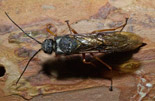Sirex noctilio Fabricius in New York State
 A fall 2004 collection of a solitary female woodwasp in a New York survey trap was identified in February 2005 as Sirex noctilio. Infested red (Pinus resinosae) and Scots (P. sylvestris) pines were subsequently found in nearby Oswego, NY later that spring. Delimitation trapping surveys conducted in summer and fall 2005 recovered Sirex noctilio specimens in 5 counties in north-central New York. This is the first record of an established population of Sirex noctilio in North America. In late 2005 and early 2006, Canada reported finding Sirex noctilio in several traps in Ontario along the St Lawrence River and areas west of Toronto. These finds significantly increase the area infested with Sirex noctilio.
A fall 2004 collection of a solitary female woodwasp in a New York survey trap was identified in February 2005 as Sirex noctilio. Infested red (Pinus resinosae) and Scots (P. sylvestris) pines were subsequently found in nearby Oswego, NY later that spring. Delimitation trapping surveys conducted in summer and fall 2005 recovered Sirex noctilio specimens in 5 counties in north-central New York. This is the first record of an established population of Sirex noctilio in North America. In late 2005 and early 2006, Canada reported finding Sirex noctilio in several traps in Ontario along the St Lawrence River and areas west of Toronto. These finds significantly increase the area infested with Sirex noctilio.
Sirex noctilio is native to Europe, Asia and northern Africa and has been inadvertently introduced into a number of countries in the southern hemisphere including: New Zealand, Australia, Uruguay, Argentina, Brazil, Chile and South Africa. In its native range, where it is generally considered to be a secondary pest, it attacks pines almost exclusively, e.g., Scots, Austrian (P. nigra), and maritime (P. pinaster) pines. In the southern hemisphere the insect has caused upwards of 80 percent mortality in plantations of North American pines especially Monterey pine (P. radiata) and loblolly pine (P. taeda). Other known susceptible pines include slash (P. elliottii), shortleaf (P. echinata), ponderosa (P. ponderosa), lodgepole (P. contorta), and jack (P. banksiana).
Interceptions of Sirex noctilio have occurred in the past. The insect is the most common species of exotic woodwasp associated with solid wood packing materials detected at U. S. ports-of-entry. In November 2003, USDA APHIS-PPQ added Sirex noctilio to their Regulated Plant Pest List.
Forest Health Protection conducted an economic analysis of the potential impacts if the Sirex infestation in NY is allowed to spread. The analysis assumed a conservative 25 mile/year spread from NY, no human-aided movement, current sawtimber and pulpwood prices, a 4% discount rate and a 10% mortality rate. Sirex would be expected to reach the loblolly pine growing areas of central Virginia in about 10 years, and within 20 years, as it spreads throughout most of North Carolina will have caused $275 million in losses to southern pines. By the time Sirex spreads throughout the southern pine growing region (55 years), it will have caused nearly $2 billion in losses.
USDA Forest Service and APHIS are members of a Sirex Science Advisory Panel and a Sirex Management Team. The first phase of the management plan is to delimit the infestation, implement regulatory controls and initiate biocontrol. The Forest Service has also developed a Pest Alert to aid in detection and a series of risk maps to identify forests that are susceptible to Sirex infestation. In 2006, APHIS and the Forest Service will support a trapping grid in New York and parts of Vermont and Pennsylvania, regulate movement of pines in 16 counties in NY and test the effectiveness of a parasitic nematode and work towards securing its regulatory clearance into the infested area.
- A Sirex noctilio introduction has been found for the first time in the US and neighboring Canada.
- 2005 delimiting surveys have found the woodwasp in five New York counties.
- Most species of southern pines, as well as Monterey, lodgepole, ponderosa and jack pines are known to be susceptible.
- Infestations of this insect in other countries have caused significant mortality in pine plantations.
- This insect is primarily a risk to the pine timber and wood fiber industry in the U.S., and potentially may cause losses of approximately $2 billion to southern pines.
- In 2006, Forest Service and APHIS will work towards delimiting the infestation, initiating regulatory controls and securing biocontrol clearance.
Forest Health Protection Contacts
Washington Office: Bob Rabaglia -- Address: USDA Forest Service, Forest Health Protection, 1601 North Kent St.-RPC 7, Arlington VA 22209; Phone: 703-605-5338; Email: brabaglia@fs.fed.us
Northeastern Area: Noel Schneeberger – Address: USDA Forest Service, Forest Health Protection, 11 Campus Blvd, Suite 200, Newtown Square, PA 19073; Phone: 610-557-4121; Email: nschneeberger@fs.fed.us
